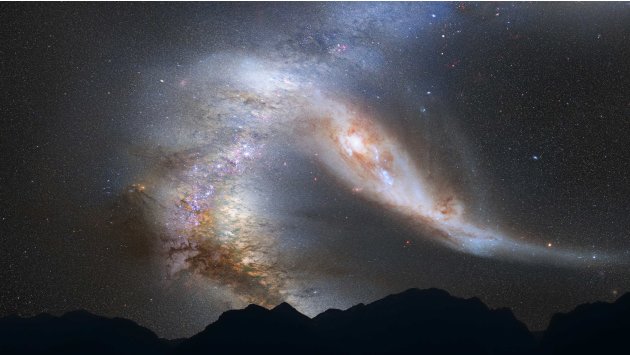The sky is seen at night just before the predicted merger between our Milky Way galaxy and the neighboring Andromeda galaxy, in this NASA photo illustration released May 31, 2012. About 3.75 billion years from now, Andromeda's disk will fill the field of view and its gravity will begin to create tidal distortions in the Milky Way. The view is inspired by dynamical computer modelling of the future collision between the two galaxies. The two ...
banyak
The Milky Way, photographed from NamibRand reserve.
A NASA Hubble Space Telescope composite image shows star cluster NGC 2060, a loose collection of stars in 30 Doradus, located in the heart of the Tarantula Nebula 170,000 light-years away in the Large Magellanic Cloud, a small, satellite galaxy of our Milky Way, in this handout photo released on April 17, 2012. The Hubble telescope imaged 30 separate fields with its Wide Field Camera 3 and Advanced Camera for Surveys during October 2011. The star...
banyak
A NASA Hubble Space Telescope composite image shows a stellar breeding ground in 30 Doradus, located in the heart of the Tarantula Nebula 170,000 light-years away in the Large Magellanic Cloud, a small, satellite galaxy of our Milky Way, in this handout photo released on April 17, 2012. The Hubble telescope imaged 30 separate fields with its Wide Field Camera 3 and Advanced Camera for Surveys during October 2011. 30 Doradus is the brightest ...
banyak
NASA's new Spitzer Space Telescope, formerly known as the Space Infrared Telescope Facility, has captured in stunning detail the spidery filaments and newborn stars of the Tarantula Nebula, in this image released Tuesday, Jan. 13, 2004, a rich star-forming region also known as 30 Doradus. This cloud of glowing dust and gas is located in the Large Magellanic Cloud, the nearest galaxy to our own Milky Way, and is visible primarily from the Southern...
banyak
Cygnus X, one of the most active regions of star birth in the Milky Way galaxy, is pictured in this NASA handout image obtained by Reuters January 10, 2012. The composite infrared image taken by NASA's Spitzer Space Telescope shows the cloud of dust and gas 4,500 light years away from earth in the constellation Cygnus. Most stars are thought to form in huge star-forming regions like Cygnus X.
Scientists using NASA's Spitzer Space Telescope observed a fledgling solar system like the one depicted in this artist's concept, finding deep within it enough water vapor to fill all the oceans on Earth five times. The scientists peered at an embryonic star called IRAS 4B located in our Milky Way galaxy about 1,000 light years from Earth in the constellation Perseus. A light year is about 6 trillion miles (10 trillion km), the distance light
from : Yahoo
- The Milky Way, photographed from NamibRand reserve.
- A NASA Hubble Space Telescope composite image shows star cluster NGC 2060, a loose collection of stars in 30 Doradus, located in the heart of the Tarantula Nebula 170,000 light-years away in the Large Magellanic Cloud, a small, satellite galaxy of our Milky Way, in this handout photo released on April 17, 2012. The Hubble telescope imaged 30 separate fields with its Wide Field Camera 3 and Advanced Camera for Surveys during October 2011. The star...banyak
- A NASA Hubble Space Telescope composite image shows a stellar breeding ground in 30 Doradus, located in the heart of the Tarantula Nebula 170,000 light-years away in the Large Magellanic Cloud, a small, satellite galaxy of our Milky Way, in this handout photo released on April 17, 2012. The Hubble telescope imaged 30 separate fields with its Wide Field Camera 3 and Advanced Camera for Surveys during October 2011. 30 Doradus is the brightest ...banyak
- NASA's new Spitzer Space Telescope, formerly known as the Space Infrared Telescope Facility, has captured in stunning detail the spidery filaments and newborn stars of the Tarantula Nebula, in this image released Tuesday, Jan. 13, 2004, a rich star-forming region also known as 30 Doradus. This cloud of glowing dust and gas is located in the Large Magellanic Cloud, the nearest galaxy to our own Milky Way, and is visible primarily from the Southern...banyak
- Cygnus X, one of the most active regions of star birth in the Milky Way galaxy, is pictured in this NASA handout image obtained by Reuters January 10, 2012. The composite infrared image taken by NASA's Spitzer Space Telescope shows the cloud of dust and gas 4,500 light years away from earth in the constellation Cygnus. Most stars are thought to form in huge star-forming regions like Cygnus X.
- Scientists using NASA's Spitzer Space Telescope observed a fledgling solar system like the one depicted in this artist's concept, finding deep within it enough water vapor to fill all the oceans on Earth five times. The scientists peered at an embryonic star called IRAS 4B located in our Milky Way galaxy about 1,000 light years from Earth in the constellation Perseus. A light year is about 6 trillion miles (10 trillion km), the distance light













